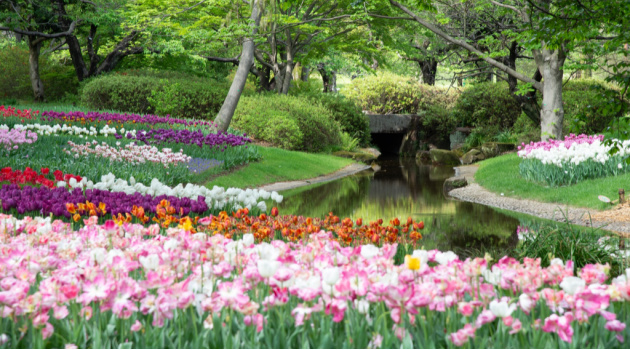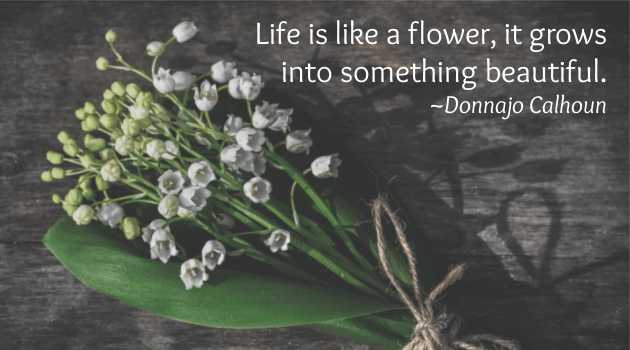Making sure that your garden will bloom every season can be challenging.
There are several factors that you have to consider to make your flowers bloom all year round. For instance, you have to consider the weather and how it’ll affect your plants or animals that may stray into your garden and could contribute to the destruction of your plants.
As a result, those events will impede the growth of your plants. While it may be challenging, there are specific techniques that you can use to sustain the flowers in your garden for the entire year. You may want to try some of the techniques we suggest today.
6 Tips for a Garden in Bloom All Season Long
Master these techniques, and you will enjoy luscious foliage and colorful blossoms for the entire growing season.
 1 – Gardening With Containers
1 – Gardening With Containers
You can use half barrels, tubs, pots to plant your flowers. It can serve as a practical way of gardening for those with limited outdoor space.
Choosing decorative or colorful pots can be a great way to add some personality and appeal to your garden. You can do is hang them on your porch, mount them on your outdoor walls, or place them on a pedestal.
You can even have a welcoming decoration on your garden’s pathway by placing two matching pots on each side of the path or even add whirligigs in your garden to accompany your welcoming containers.
While your plants are still growing, your colorful pots can keep your outdoor space vibrant. They can also be a great option for more seasonal plants, as if one plant dies you can move a new pot to its place and fill the gaps.
2 – Choosing Appropriate Plants For Your Region
Not all plants can bloom in any location. That’s why you have to choose suitable plants depending on your location. Don’t buy all the seeds or potted flowers without knowing which ones will bloom in your region.
You may notice that some people can quickly grow plants every season. It’s easy for them to grow any colors they want, depending on the season. That’s because they know which ones are the best for growing in the location.
Some plants are seasonal, and it would be a good idea to determine which plants are in season to give you more success with your gardening efforts. With some knowledge, you can combine these seasonal plants to help you to sustain your garden in every season.
3 – Use Fully Composted Yard Waste
The next thing you should do is use composted yard waste. Using it in your garden has both advantages and disadvantages.
While composts are great for growing plants in your garden, they can harm sensitive plants, and some compost, if not appropriately treated, may cause diseases to the plants.
To make sure that the compost is safe to use for your garden, you should leave it for an adequate amount of time to ensure that there are no harmful pathogens within the compost soil.
When adequately treated, compost feeds both your plants and your soil with additional nutrients
Compared to the fertilizers sold in the market, compost has more nutrients such as iron, zinc, potassium, and manganese. All of which can positively affect the growth of your plants.
4 – Deadheading
As part of maintaining your garden to have year-round color, you must not forget deadheading. While flowers help to improve the appearance of your garden, each flower has its life span. As these flowers start to dry up your garden becomes less attractive.
You may find it scary to cut back the wilted parts from your plants. Or you may think that it may harm your plants if you remove them. However, it’s completely normal.
In fact, it’s essential to get rid of the wilted flowers from your plants, which is known as deadheading. Apart from keeping your garden looking clean, it also improves your plants’ health. Thus, the flower grows thicker and fuller.
For some, deadheading may be a tedious job. However, it’s relatively easy as long as you keep on top of it.
5 – Pruning
Another way to keep your plants from pests and any damages they may incur is by pruning. This is one of the strategies that are necessary to maintain the shape of your plant.
As mentioned, removing lifeless parts from your plant is essential to ensure its growth and to keep its shape. When you’re pruning, you’re removing dying or dead parts of your shrub, such as branches, buds, and roots. By doing this, you’re allowing the plant to thrive while enhancing your garden’s aesthetics.
On the other hand, if you don’t prune, the lifeless parts of a plant may hinder the new ones from growing. As such, the plants may not be able to utilize the nutrients they get. Wilted parts may soon decay, and in effect, could attract unwanted insects that can eventually destroy your plants.
When you are gardening, you usually follow a particular landscape for it and sometimes this requires you to keep on top of shaping plants so that you don’t ruin the overall landscape design.
As mentioned, pruning is vital to promoting new growth, and keeping your garden blooming and looking tidy.
6 – Don’t Overdo It
When choosing plants and colored pots, it is best if you’re careful. It’s still important to have a color palette that mixes well to keep your garden pleasing to look at.
Avoid mixing all of the colors. What you can do is set the mood of your garden using different color schemes. For instance, you can make your garden be calming by having silver foliage and lighter pastel hues. Or make it sophisticated and harmonious with bright greens and purple colors.
Whatever color you want, make sure to use the ones that will complement each other. Remembering that planning for your garden design is essential.
The Takeaway: It’s Well Worth Your Effort to Learn the Technique of Creating Blooms for the Entire Season
It’s easy to keep your garden colorful all year round. You may want to follow the tips above so you can achieve a vibrant garden no matter what the season is. So now you know the secrets to enjoying the sights, aromas, and sounds of nature throughout the growing season.
Learning to use different strategies will not only keep the flowers in bloom every season.



